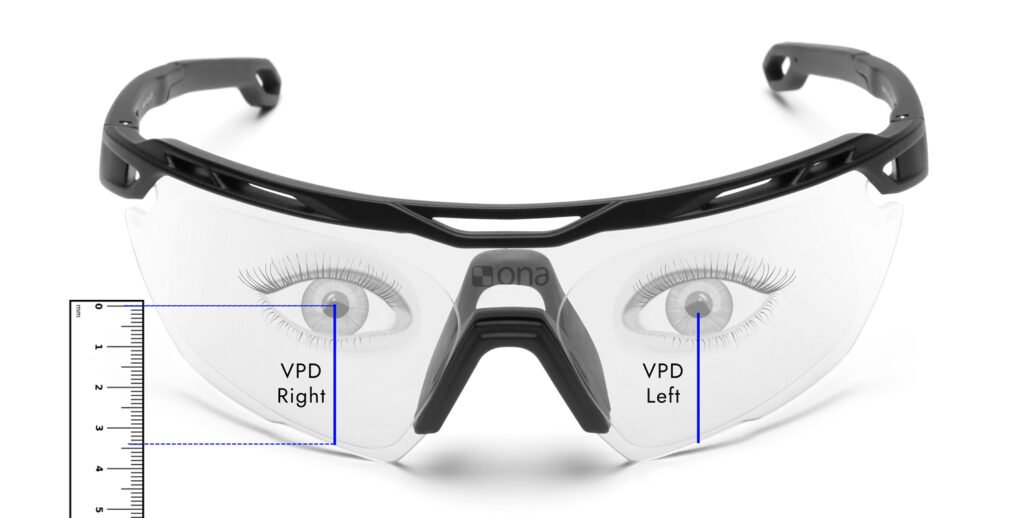You will need to complete this form with your prescription including your Vertical Pupillary Distance and your Horizontal Pupillary Distance.
Your prescription must include your Vertical Pupillary Distance (VPD) and your Horizontal Pupillary Distance (HPD). Please see the next few questions below.
What is Vertical Pupillary Distance (VPD)?
Vertical Pupillary Distance (VPD) is the measurement of the distance between the center of your pupil and the bottom edge of an eyeglass or contact lens. It ensures proper alignment for clear vision and comfort, especially in multifocal lenses. Accurate VPD measurements are crucial for optimal eyewear fitting and visual performance.
How do I measure Vertical Pupillary Distance (VPD) in ONA VCP21 RX?
For Ona RX lenses, the Vertical Pupillary Distance (VPD) refers to the measurement from the center of the pupil to the bottom edge of the lens (NOT the frame). This measurement ensures precise alignment for clear vision and optimal visual performance.
To determine your Vertical Pupillary Distance (VPD), you have a couple of options:
1. Contact Your Optician: If you’ve received prescription glasses from an optician before, reaching out to them directly is a good choice for assistance. This measurement must be taken wearing your ONA VCP21 RX with the blank shield provided.
REMEMBER: the Vertical Pupillary Distance (VPD) refers to the measurement from the center of the pupil to the bottom edge of the lens (NOT the frame).
2. Measure with Assistance: If you’re measuring with someone’s help, follow these steps:
a. Position yourself facing the person and look straight ahead with both eyes open wearing your ONA VCP21 RX with the blank shield provided.
b. The person should hold a millimeter-marked ruler up to your right eye, aligning the ruler’s zero with the center of your pupil.
c. Measure the distance from the center of your right pupil to the bottom edge of the frame.
d. Repeat the same process for your left eye.
Ensure accuracy by taking multiple measurements.
Another approach:
a. Face the person and look straight ahead with both eyes open.
b. Have the person mark the center of each pupil on the blank shield using a black marker.
c. Use a small ruler to measure the distance from the bottom edge of the lens to the marked dot on each pupil.
These methods help determine your VPD, which is crucial for optimal alignment and clear vision with your ONA VCP21 RX.
Remember, for precise measurements, consulting a professional is recommended.
What is Horizontal Pupillary Distance (HPD)?
Horizontal Pupillary Distance (HPD) is the measurement in millimeters between the centers of your pupils, crucial for accurately aligning eyeglass lenses with your eyes to ensure optimal visual clarity and comfort. It’s essential to get an accurate HPD measurement as it affects how the light entering the lenses aligns with your pupils. If the lenses are not centered properly over your pupils, it can lead to issues like eye strain, visual distortion, and discomfort.
How do I measure Horizontal Pupillary Distance (HPD) in ONA VCP21 RX?
To determine your Horizontal Pupillary Distance (HPD), you have a couple of options:
1. Contact Your Optician: If you’ve received prescription glasses from an optician before, reaching out to them directly is a good choice for assistance. This measurement must be taken wearing your ONA VCP21 RX with the blank shield provided.
2. Measure with Assistance: If you’re measuring with someone’s help, follow these steps:
a. Position yourself facing the person and look straight ahead with both eyes open wearing your ONA VCP21 RX with the blank shield provided. You’ll also need a small ruler with millimeter markings
b. Take the ruler and align its zero mark with the center of their right pupil. Then, measure the distance from the center of the right pupil to the center of the left pupil.
The millimeter number on the ruler that lines up with the center of the left pupil is your HPD measurement. For accuracy, you can repeat the measurement a few times.
Another approach:
a. Face the person and look straight ahead with both eyes open.
b. Have the person mark the center of each pupil on the blank shield using a black marker.
c. Use a small ruler to measure the distance between the 2 dots.
For accuracy, you can repeat the measurement a few times.
Remember, for precise measurements, consulting a professional is recommended.


